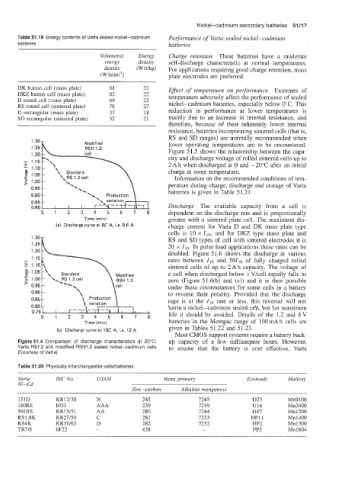Page 577 - Battery Reference Book
P. 577
Nickel-cadmium secondary batteries 51/17
Table 51.19 Energy contents of Varta sealed nickel-cadmium Performance of Varta sealed nickel-cadmium
batteries batteries
Volumetric Energy Charge retention These batteries have a moderate
energy density self-discharge characteristic at normal temperatures.
density (Whkg) For applications requiring good charge retention, mass
(W h/dm3) plate electrodes are preferred.
DK button cell (mass plate) 61 21 Effect of temperature on performance Extremes of
DKZ button cell (mass plate) 62 22 temperature adversely affect the performance of sealed
D round cell (mass plate) 69 22 nickel-cadmium batteries, especially below 0°C. This
RS round cell (sintered plate) 78 27
D rectangular (mass plate) 31 18 reduction in performance at lower temperatures is
SD rectangular (sintered plate) 52 21 mainly due to an increase in internal resistance, and
therefore, because of their inherently lower internal
resistance, batteries incorporating sintered cells (that is,
RS and SD ranges) are normally recommended when
Modified lower operating temperatures are to be encountered.
RSH 1.2 Figure 51.5 shows the relationship between the capa-
1.20
city and discharge voltage of rolled sintered cells up to
2 Ah when discharged at 0 and -20°C after an initial
:::: L . Production \ perature during charge, discharge and storage of Varta
charge at room temperature.
Information on the recommended conditions of tem-
\
batteries is given in Table 51.21.
-3 -- -
0.85 ..a .% '\ variation
0.80 I I I --I Discharge The available capacity from a cell is
0 1 2 3 4 5 6 7 8 dependent on the discharge rate and is proportionally
Time (mini greater with a sintered plate cell. The maximum dis-
(ai Discharge curve at 8C A, i.e. 9.6 A charge current for Varta D and DK mass plate type
cells is 10 x Zlo, and for DKZ type mass plate and
RS and SD types of cell with sintered electrodes it is
20 x Zlo. In pulse load applications these rates can be
doubled. Figure 51.6 shows the discharge at various
rates between Zlo and 50110 of fully charged rolled
sintered cells of up to 2Ah capacity. The voltage of
Modified a cell when discharged below 1 Vkell rapidly falls to
FISH 1.2 zero (Figure 51.6(b) and (c)) and it is then possible
under these circumstances for some cells in a battery
to reverse their polarity. Provided that the discharge
0.85 Production rage is at the Zl0 rate or less, this reversal will not
0.80 harm a nickel-cadmium sealed cell, but for maximum
0.75 life it should be avoided. Details of the 1.2 and 6V
0 1 2 3 4 5 6 7 8
Time (rnin) batteries in the Mempac range of IOOmAh cells are
(bi Discharge curve at 1OC A, i.e. 12 A given in Tables 5 1.22 and 5 1.23.
Most CMOS support systems require a battery back-
Figure 51.4 Comparison of discharge characteristics at 20°C: up capacity of a few milliampere hours. However,
Varta RS1.2 and modified RSHI .2 sealed nickel-cadmium cells to ensure that the battery is cost effective, Varta
(Courtesy of Varta)
Table 51.20 Physically interchangeable cells/batteries
Varfa IEC No. USASI Varta primary Eveready Malloiy
Ni-Cd
Zinc-carbon Alkaline manganese
151D KR12/30 N 245 7245 D23 Mn9 100
180RS R03 AAA 239 7239 U16 Mn2400
501RS KR15/51 AA 280 1244 HP7 Mn1500
RS1.8K KR27/50 C 28 1 7233 HP11 Mn1400
RS4K KR35/62 D 282 7232 HP2 Mn1300
TR7/8 6F22 - 438 - PP3 Mn1600

